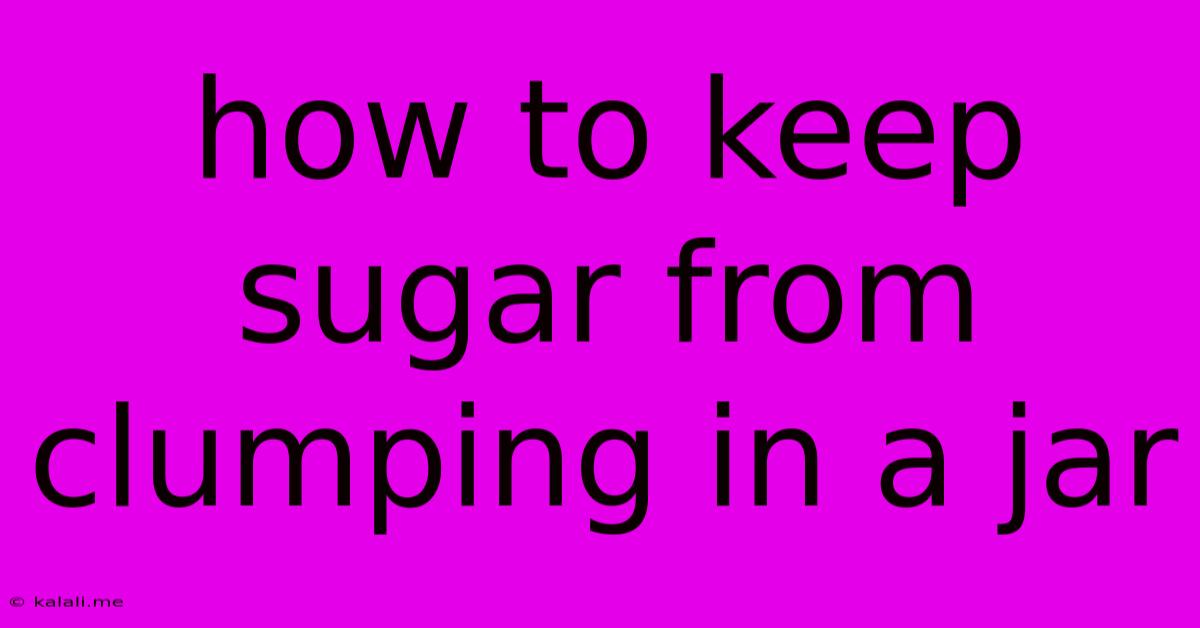How To Keep Sugar From Clumping In A Jar
Kalali
Jun 08, 2025 · 3 min read

Table of Contents
How to Keep Sugar From Clumping in a Jar: A Sweet Solution
Sugar clumping is a common kitchen frustration. That once-free-flowing granulated sugar suddenly becomes a solid, frustrating block. This article explores the science behind sugar clumping and offers practical solutions to keep your sugar perfectly pourable, saving you time and aggravation. We'll cover everything from proper storage to clever tricks to ensure your sugar stays lump-free.
Understanding the Enemy: Humidity and Sugar Crystals
Sugar clumps because of moisture. Granulated sugar is made up of tiny crystals. These crystals attract and absorb water molecules from the air, a process called hygroscopy. When enough moisture is absorbed, the crystals dissolve slightly and recrystallize, binding together to form clumps. This process is accelerated in humid environments.
Several factors contribute to sugar clumping:
- Humidity: High humidity is the biggest culprit. Air with high moisture content readily transfers water to the sugar crystals.
- Temperature fluctuations: Changes in temperature can cause condensation within the container, leading to moisture buildup.
- Air exposure: Direct exposure to air allows moisture to reach the sugar more easily.
- Contamination: Introduction of moisture from spilled liquids or even damp spoons can kickstart the clumping process.
Effective Strategies to Prevent Sugar Clumping
Here's how to keep your sugar smooth and free-flowing:
1. Airtight Storage is Key:
- Invest in airtight containers: This is the single most important step. Choose containers specifically designed for storing dry goods, featuring airtight seals that prevent moisture from entering. Glass jars with rubber seals or plastic containers with locking lids are excellent options.
- Proper sealing: Ensure the lid is tightly sealed after each use to prevent air and moisture from entering.
2. The Power of Dry Environments:
- Store in a cool, dry place: Avoid storing sugar in humid areas like near sinks or stoves. A cool, dry pantry is ideal.
- Consider a desiccant: Placing a small packet of silica gel (often found in shoe boxes or electronics packaging) inside the container can absorb excess moisture.
3. Preemptive Measures:
- Rice trick: Some people swear by adding a few uncooked rice grains to the sugar jar. The rice supposedly absorbs excess moisture. While the effectiveness is debated, it's a common and harmless technique.
- Clean scoops: Always use a completely dry spoon to scoop sugar. Wet spoons introduce moisture, accelerating clumping.
4. Dealing with Already Clumped Sugar:
If your sugar has already started clumping, don't despair! You can often revive it:
- The oven method: Place the sugar in an oven preheated to 250°F (120°C) for about 5-10 minutes. This low heat will gently dry out the sugar and break up the clumps. Monitor closely to prevent burning.
- The rolling pin method: If only a few clumps have formed, you can often break them up by placing the sugar in a sealed bag and rolling it with a rolling pin.
- The food processor method: For heavily clumped sugar, a short burst in a food processor can quickly break down the clumps.
Maintaining Your Sugar's Flow: Ongoing Best Practices
By following these simple steps, you can significantly reduce the chances of sugar clumping and enjoy smoothly flowing sugar every time. Remember, consistent, careful storage is the most effective long-term solution. Regularly check your sugar for any signs of clumping and address the issue promptly to maintain its quality and prevent future problems.
Latest Posts
Latest Posts
-
I Smell Sex And Candy Nirvana
Jun 08, 2025
-
Do Avx Cpu Core Fixed On Mac
Jun 08, 2025
-
How To Clear Messages On Android
Jun 08, 2025
-
Can Be Standard Deviation Be Calc If Not Independent
Jun 08, 2025
-
Does A Charged Battery Weigh More
Jun 08, 2025
Related Post
Thank you for visiting our website which covers about How To Keep Sugar From Clumping In A Jar . We hope the information provided has been useful to you. Feel free to contact us if you have any questions or need further assistance. See you next time and don't miss to bookmark.